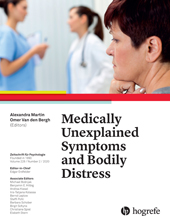Abstract
Abstract. Health anxiety, characterized by excessive concern about one’s health, is a serious and costly public health problem. The disorder might become chronic if left untreated. Unfortunately many patients do not receive timely or proper treatment due to sparse treatment resources. Also, existing treatment programs, though effective for many, do not work for all. This paper discusses the conceptualization of health anxiety and future directions based on novel research findings. These include: (i) the content and characteristics of autobiographical memories and episodic future thoughts in severe health anxiety, (ii) related concepts such as cyberchondria with excessive Internet browsing on health issues and health anxiety by proxy, where parents display and might confer health anxiety towards their children, (iii) an epidemiological perspective on the association between health anxiety and subclinical psychotic experiences in preadolescence. Exploring these new dimensions could have important implications for the further development of preventive strategies and effective treatment.
References
. (1968). Diagnostic and statistical manual of mental disorders (2nd ed.). Washington, DC: American Psychiatric Association. https://doi.org/10.1176/appi.books.9780890425596
. (1980). Diagnostic and statistical manual of mental disorders (3rd ed.). Washington, DC: American Psychiatric Association.
. (1987). Diagnostic and statistical manual of mental disorders (3rd ed., revision). Washington, DC: American Psychiatric Association.
. (1994). Diagnostic and statistical manual of mental disorders (4th ed.). Washington, DC: American Psychiatric Association.
. (2000). Diagnostic and statistical manual of mental disorders (4th ed., text revised). Washington, DC: American Psychiatric Association.
. (2013). Diagnostic and statistical manual of mental disorders (5th ed.). Washington, DC: American Psychiatric Association.
(2010). Health anxiety: Current perspectives and future directions. Current Psychiatry Reports, 12, 306–312. https://doi.org/10.1007/s11920-010-0123-9
(2017). Cognitive behaviour therapy for health anxiety: A systematic review and meta-analysis. Behavioural and Cognitive Psychotherapy, 45, 110–123. https://doi.org/10.1017/s1352465816000527
(2018). The associated features of multiple somatic symptom complexes. Journal of Psychosomatic Research, 112, 1–8. https://doi.org/10.1016/j.jpsychores.2018.06.007
(2004). A new, empirically established hypochondriasis diagnosis. American Journal of Psychiatry, 161, 1680–1691. https://doi.org/10.1176/appi.ajp.161.9.1680
(2019). Autobiographical memory and episodic future thinking in severe health anxiety: A comparison with obsessive-compulsive disorder. Cognitive Therapy and Research, 44, 89–107. https://doi.org/10.1007/s10608-019-10058-3
(2017). Schizophrenia – an anxiety disorder? British Journal of Psychiatry, 211, 262–263. https://doi.org/10.1192/bjp.bp.116.195370
(2007). From cenesthesias to cenesthopathic schizophrenia: A historical and phenomenological review. Psychopathology, 40, 361–368. https://doi.org/10.1159/000106314
(2015). Family background of modern health worries, somatosensory amplification, and health anxiety: A questionnaire study. Journal of Health Psychology, 20, 1549–1557. https://doi.org/10.1177/1359105313516661
(2000). Intergenerational transmission of gastrointestinal illness behavior. American Journal of Gastroenterology, 95, 451–456. https://doi.org/10.1016/S0002-9270(99)00825-4
(2016). Health anxiety in children and parents. British Medical Journal, 353, 2891. https://doi.org/10.1136/bmj.i2891
(2007). Intergenerational transmission of health beliefs in somatoform disorders. British Journal of Psychiatry, 191, 449–450.
(2019). The relationships between health anxiety, online health information seeking, and cyberchondria: Systematic review and meta-analysis. Journal of Affective Disorders, 245, 270–278. https://doi.org/10.1016/j.jad.2018.11.037
(2010). Intrusive imagery in severe health anxiety: Prevalence, nature and links with memories and maintenance cycles. Behaviour Research and Therapy, 48, 792–798. https://doi.org/10.1016/j.brat.2010.05.008
(2012). Cyberchondriasis: Fact or fiction? A preliminary examination of the relationship between health anxiety and searching for health information on the Internet. Journal of Anxiety Disorders, 26, 189–196. https://doi.org/10.1016/j.janxdis.2011.11.005
(2009). Medically unexplained symptoms, somatisation disorder and hypochondriasis: Course and prognosis. A systematic review. Journal of Psychosomatic Research, 66, 363–377. https://doi.org/10.1016/j.jpsychores.2008.09.018
(1988). Hypochondriacal psychoses: A long-term follow-up. Acta Psychiatrica Scandinavica, 77, 587–597.
(2014). Disordered Self in the Schizophrenia Spectrum. Harvard Review of Psychiatry, 22, 251–265. https://doi.org/10.1097/hrp.0000000000000040
(2012). Health anxiety disorders: A cognitive construal. Behaviour Research and Therapy, 50, 502–512. https://doi.org/10.1016/j.brat.2012.05.001
(2019). Psychotic experiences are associated with health anxiety and functional somatic symptoms in preadolescence. Journal of Child Psychology and Psychiatry, 60, 524–532. https://doi.org/10.1111/jcpp.12986
(2016). The relationship of hypochondriasis to anxiety, depressive, and somatoform disorders. Psychosomatics, 57, 200–207. https://doi.org/10.1016/j.psym.2015.10.006
(2014). Cenesthopathy in adolescence: an appraisal of diagnostic overlaps along the anxiety-hypochondriasis-psychosis spectrum. Comprehensive Psychiatry, 55, 1122–1129. https://doi.org/10.1016/j.comppsych.2014.02.007
(2014). Boundaries and overlap between hypochondriasis and other disorders: Differential diagnosis and patterns of co-occurrence. Current Psychiatry Reviews, 10, 24–33. https://doi.org/10.2174/1573400509666131119011010
(2015). Will hypochondriasis be alive and well in the ICD-11? Australian and New Zealand Journal of Psychiatry, 49, 88. https://doi.org/10.1177/0004867414559136
(2013). Cyberchondria: Towards a better understanding of excessive health-related Internet use. Expert Review of Neurotherapeutics, 13, 205–213. https://doi.org/10.1586/ern.12.162
(2016). The classification of Obsessive-Compulsive and Related Disorders in the ICD-11. Journal of Affective Disorders, 190, 663–674. https://doi.org/10.1016/j.jad.2015.10.061
(2018). Social learning pathways in the relation between parental chronic pain and daily pain severity and functional impairment in adolescents with functional abdominal pain. Pain, 159, 298–305. https://doi.org/10.1097/j.pain.0000000000001085
(2017). Health anxiety by proxy in women with severe health anxiety: A case control study. Journal of Anxiety Disorders, 52, 8–14. https://doi.org/10.1016/j.janxdis.2017.09.001
(2017). Effects of maternal health anxiety on children’s health complaints, emotional symptoms, and quality of life. European Child and Adolescent Psychiatry, 26, 591–601. https://doi.org/10.1007/s00787-016-0927-1
(2019). Increase in the prevalence of health anxiety in medical clinics: Possible cyberchondria. International Journal of Social Psychiatry, 65, 566–569. https://doi.org/10.1177/0020764019866231
(2016). Health anxiety: The silent, disabling epidemic. British Medical Journal, 353, 10–11. https://doi.org/10.1136/bmj.i2250
(2016). Psychosis as a transdiagnostic and extended phenotype in the general population. World Psychiatry, 15, 118–124. https://doi.org/10.1002/wps.20310
(1990). Hypochondriasis. Behaviour Research and Therapy, 28, 105–117.
(2000). Anxiety sensitivity mediates the relationships between childhood learning experiences and elevated hypochondriacal concerns in young adulthood. Journal of Psychosomatic Research, 49, 107–118. https://doi.org/10.1016/S0022-3999(00)00097-0
. (1974). Glossary of mental disorders and guide to their classification: For use in conjunction with the international classification of diseases, 8th revision. Geneva, Switzerland: World Health Organization.
. (1978). Mental disorders: Glossary and guide to their classification in accordance with the ninth revision of the international classification of diseases. Geneva, Switzerland: World Health Organization.
. (1993). The ICD-10 classification of mental and behavioural disorders. Diagnostic criteria for research. Geneva, Switzerland: World Health Organization.
. (2019). ICD-11 for mortality and morbidity statistics. Retrieved from https://icd.who.int/browse11/l-m/en
(2017). The relationship between childhood health anxiety, parent health anxiety, and associated constructs. Journal of Health Psychology, 22, 617–626. https://doi.org/10.1177/1359105315610669



